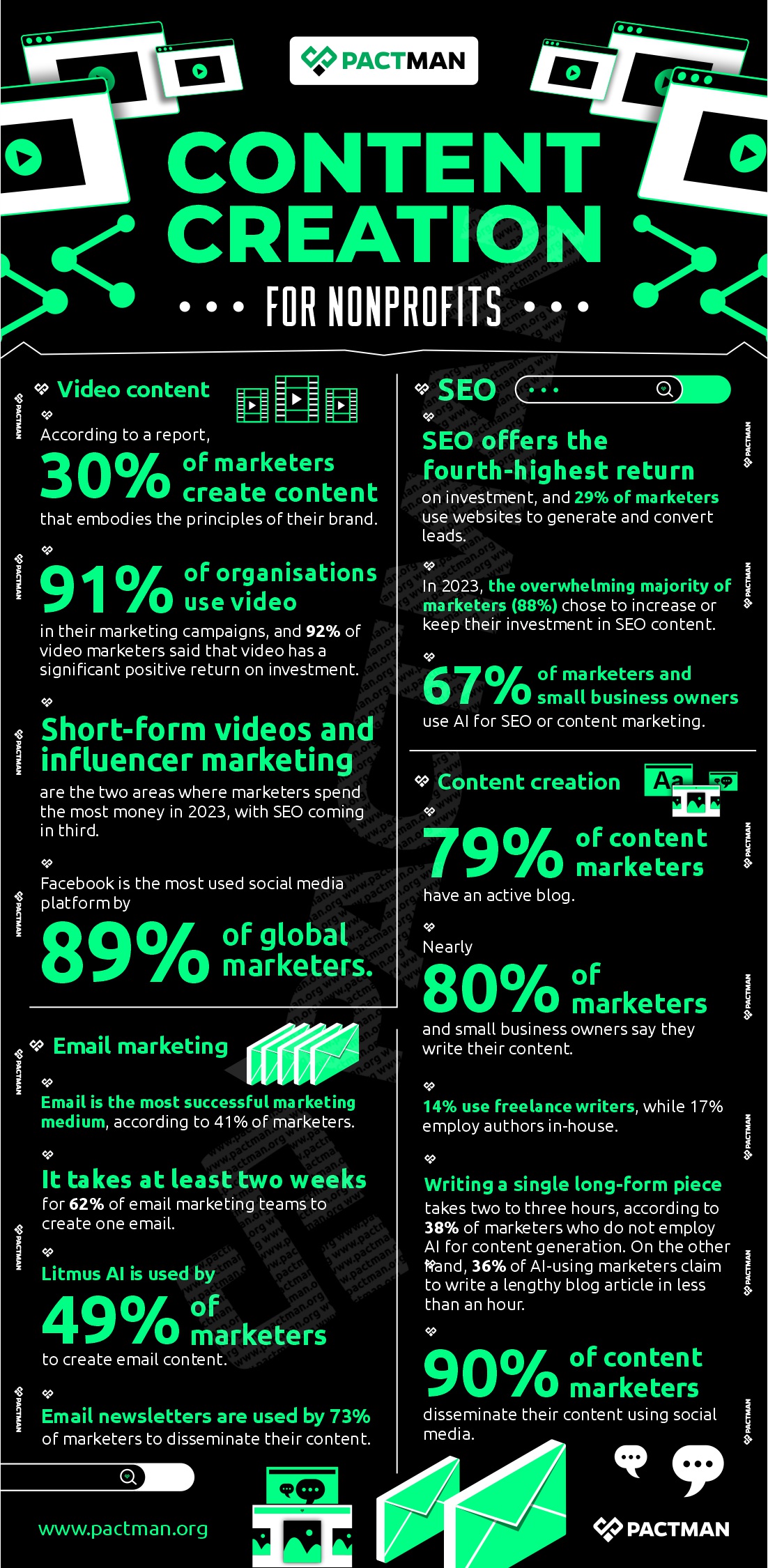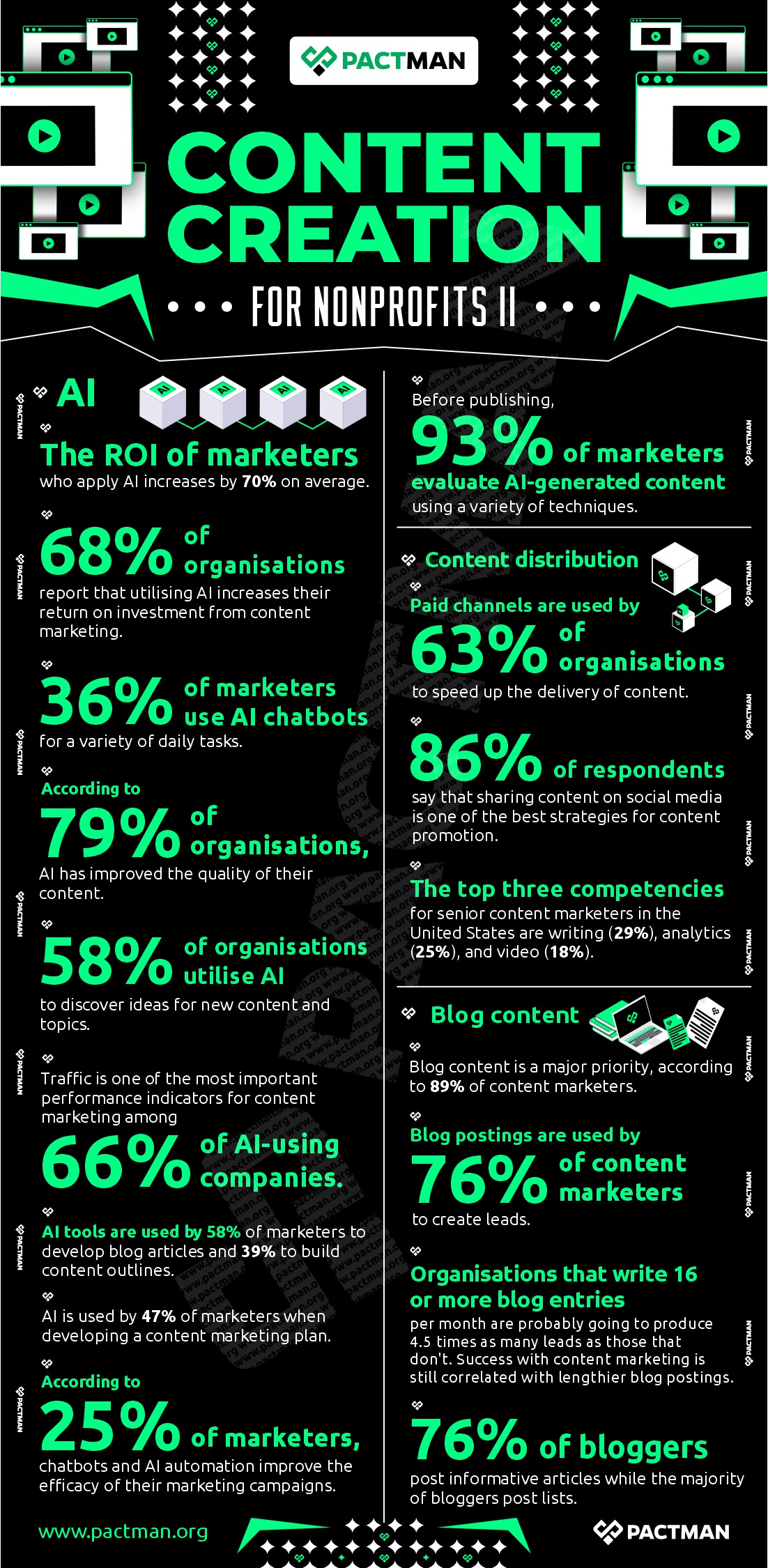I
Introduction
What keeps us all informed is content as it aids in directing our choices. Hence, generating ideas, creating written or visual content, and then disseminating it to your target audience via the various channels at your disposal form the foundation of the content creation process.

Everyone loves dazzling content. However, excellent content is more than just flawlessly constructed sentences. Content creators must choose from a wide variety of content categories, each with unique requirements, challenges, and advantages. For the most part, observing how other people create content might sometimes be the simplest way to get inspired.
Likewise, keeping the content on your social media accounts up to date can be challenging. Not to mention, it can be challenging to come up with a fresh perspective, an original idea, or something that doesn’t read and appears like every other created post—even with a content calendar.
A strong brand story is undoubtedly an art, but you also need to think about the technical aspects that might help your audience find your content more reliable and fulfilling. Even more, your writing style, tone, emotional resonance, and correctness all affect how valuable you are perceived by your audience. This article will consider the process of effective content creation for nonprofits and the need for relevant content.
II
Content Creation 101: Exploring the Fundamentals and Key Concepts
Content creation is the deliberate process of creating, developing, and disseminating content that is valuable, pertinent, and consistent to draw in and hold on to a target audience. By and large, various mediums, including articles, films, podcasts, infographics, and social media posts make up the process. Altogether, they are designed to educate, amuse, or solve issues for the intended audience.

To begin with, content isn’t just about storytelling; it’s about telling a true story well. In addition, building relationships and trust with the audience are the goals of good content creation, which extends beyond marketing strategies. Hence, creating content is essential to developing thought leadership.
Organisations that produce intelligent, high-quality content position themselves as authorities and become leaders in their respective industries. Whether the goal is to engage your readers, establish brand authority, or raise awareness, content must align with strategic goals.
Also, creating valuable and genuine content regularly builds brand identification and trust. Organisations that place a high priority on creating relevant content have a big edge in a crowded digital space where readers are overloaded with information. In addition to being a marketing role, content creation is a strategic asset that promotes innovation, increases stakeholder engagement, and fosters long-term growth.
III
Critical Content Creation Statistics to Consider
Statistics provide context or qualitative information to the topic of discussion. It can guide your organisation to develop content that aligns with the preferences and needs of your audience.
More importantly, you can steer clear of guesswork in your content marketing endeavours by using a statistical method. The correct statistics are also necessary for a successful marketing plan.
This section will provide some marketing data in this chapter to help in your content creation strategy.

a. Video content
According to a report, 30% of marketers create content that embodies the principles of their brand. Additionally, 91% of organisations use video in their marketing campaigns, and 92% of video marketers said that video has a significant positive return on investment.
Short-form videos and influencer marketing are the two areas where marketers spend the most money in 2023, with SEO coming in third. Also, Facebook is the most used social media platform by 89% of global marketers.
b. SEO
SEO offers the fourth-highest return on investment, and 29% of marketers use websites to generate and convert leads. Hence, in 2023, the overwhelming majority of marketers (88%) chose to increase or keep their investment in SEO content. 67% of marketers and small business owners use AI for SEO or content marketing.

c. Content creation
79% of content marketers have an active blog. Also, nearly 80% of marketers and small business owners say they write their content. 14% use freelance writers, while 17% employ authors in-house.
Writing a single long-form piece takes two to three hours, according to 38% of marketers who do not employ AI for content generation. On the other hand, 36% of AI-using marketers claim to write a lengthy blog article in less than an hour. 90% of content marketers disseminate their content using social media.
d. Email marketing
Email is the most successful marketing medium, according to 41% of marketers. It takes at least two weeks for 62% of email marketing teams to create one email.
Litmus AI is used by 49% of marketers to create email content. Also, email newsletters are used by 73% of marketers to disseminate their content.
e. AI
The ROI of marketers who apply AI increases by 70% on average. Furthermore, 68% of organisations report that utilising AI increases their return on investment from content marketing.
36% of marketers use AI chatbots for a variety of daily tasks. According to 79% of organisations, AI has improved the quality of their content. Also, 58% of organisations utilise AI to discover ideas for new content and topics. Traffic is one of the most important performance indicators for content marketing among 66% of AI-using companies.
AI tools are used by 58% of marketers to develop blog articles and 39% to build content outlines. Even more, AI is used by 47% of marketers when developing a content marketing plan. According to 25% of marketers, chatbots and AI automation improve the efficacy of their marketing campaigns. Before publishing, 93% of marketers evaluate AI-generated content using various techniques.
f. Content distribution
63% of organisations use paid channels to speed up content delivery. Also, 86% of respondents say that sharing content on social media is one of the best strategies for content promotion. The top three competencies for senior content marketers in the United States are writing (29%), analytics (25%), and video (18%).
g. Blog content
Blog content is a major priority, according to 89% of content marketers. Additionally, blog postings are used by 76% of content marketers to create leads. Organisations that write 16 or more blog entries per month are probably going to produce 4.5 times as many leads as those that don’t. Success with content marketing is still correlated with lengthier blog postings. Also, 76% of bloggers post informative articles while the majority of bloggers post lists.
IV
Content Creation Processes for Nonprofits
Your efforts to accomplish your organisation’s objectives will be aided by creating a content strategy. Essentially, the mantra is; to know your audience, establish clear objectives for the content you want to create, and thoroughly evaluate previously created content to see whether it needs to be updated.

In this section, we will consider the crucial processes that must be put in place to manage the content creation process.
1. Content Creation
There are two categories of content creation processes:
- streaming content and
- non-streaming content.
The term “streaming content” refers to the presentation of interviews, audio/video features, songs, mp3 files, movie clips, and other multimedia elements such as real-time audio/video, movies, video conferencing, etc. In contrast, text, images, graphics, and other content are displayed as static or dynamic pages in the non-streaming format.
Accordingly, streaming and non-streaming content are presented and stored differently. While streaming content must be kept on a media server, such as a real player or media player, non-streaming content must be kept on a database server. Hence, one must decide on the delivery method and develop the content appropriately.
2. Content Management
With the aid of a content management system (CMS), an organisation can make available the content that is kept on many servers across various regions and distribute it in response to user inquiries. Because the CMS platforms overlap with various types of systems, such as e-commerce portals among others, its limits are hazy.
All in all, the CMS aids in content creation and publication, ensures more economical content management, and ensures improved decision-making. Through process automation and integration, it facilitates the efficient and successful delivery of content in the necessary format, whether it be printouts, CD-ROMs, the Internet, etc.
3. Content Distribution
Web servers, content management systems, and database servers are channels used to deliver the content. Also, audio snippets, documents, frames, photographs, news snippets, pictures, posters, reviews, web pages, and advertisements are all considered data.
Ad servers are used by the majority of internet organisations to control and track their online ads. Additionally, some employ different chat servers to minimise bandwidth usage, which is necessary for speedy downloads.
Disaster recovery and data management also require the provision of a backup server. All in all, the effectiveness of content marketing is rated higher by those who have a strategy than by those who don’t.
V
Effective Steps to Content Creation
This section will consider the various measures that can be adopted by nonprofits in the successful process of content creation.

1. Who develops the content?
Primarily, when choosing the ideal creative model, you should take into account elements like your nonprofit’s nature, the competition for content, the level of skill needed, and the team and financial resources. Among the factors are:
- Selecting writers for a team working internally: By and large, this process can be more easily managed with full-time writing talents if your organisation places a high priority on creating original content. This also includes organisations that generate a large number of assets, or require content for a variety of channels and platforms.
- Making use of internal staff and subject matter experts (SMEs): This comprises coworkers from different organisational functions. Oftentimes, this strategy is useful if the discussions surrounding your nonprofits call for specific knowledge or technical proficiency. You can also benefit from the knowledge of managers, employers, upper management, and other staff members. It might be more effective to train your content team to be subject matter experts rather than teaching them to be excellent writers.
- Outsourcing to experts or consultants: Also, nonprofits that aren’t prepared to invest in full-scale editorial capabilities may choose to collaborate with a content agency or other creative service provider, or they may choose to hire paid contributors, including qualified journalists.
- Recruiting outside contributors: Lastly, a nonprofit with a sizable, active audience may invite prominent figures in the field to provide guest posts to its media channels. These authors frequently offer their knowledge in return for priceless backlinks and fresh audience exposure.
2. In what ways will content support your strategic objectives?
Sharing worthwhile, captivating content that your audience will enjoy is a commendable objective. Of course, that love fest needs to be supported by a strategic marketing goal. By creating content in the styles and manner that your target audience prefers, you can capture their interest.
Even more, it’s crucial to position your content to optimise engagement and conversion. If not, you merely spin the wheels of the content engine without gaining any real traction.
Without a doubt, it takes a top-down approach to achieve strategic and creative alignment. Let’s begin by discussing the tactical and practical choices that need to be made before coming up with a single word or image.
- Examine your options for format and content kind. Short articles, videos, case studies, and virtual events continue to be the most popular content forms and kinds. However, this popularity does not necessarily indicate that these content options are the most appropriate for your audience or readers. Using a less common or more specialised strategy could make your content more unique. Also, recognise the advantages and disadvantages of each choice before making a decision.
- Decide on your strategy. The next challenge is to make your content stand out from the others. You might discover a content niche, which is a topic or focus area where your brand can offer readers useful advice and original thought leadership that they won’t find elsewhere. When you concentrate your creative energies on a single subject, you may avoid the paralysis that occurs when you attempt to fill too many content buckets at once. Additionally, everything developed under that topic will naturally connect to your strategic goal.
3. How will you write stories that will captivate and delight your audience?
Successful content creation in marketing requires more. It goes beyond the typical creative considerations of choosing themes, coming up with story ideas, and maintaining high levels of inventiveness and quality.
More importantly, your content must act as a medium for sharing the distinctive viewpoints, skills, and passion of your organisation. Additionally, it should convey a narrative that appeals to and motivates your target audience.
a. Choose valuable subject content
Start your creative brainstorming by deciding what topics to write about. Whatever doesn’t accurately and meaningfully represent your nonprofit’s identity should be ignored. To tackle this challenge, determine the main topics that your target audience actively looks up and create content around the subject area.
Topic cluster modelling or keyword research can help you better understand their challenges and the kinds of content that could aid them.
b. Optimise Content
Also, Google’s continuous core upgrades serve as a reminder that you should concentrate on providing your audience with a positive, excellent experience. Likewise, to maximise the search impact of your content, respond to donor inquiries, show off your nonprofit’s subject-matter experience, competence, authoritativeness, and trustworthiness (EEAT), and supplement current discussions with valuable information.
c. Come up with ideas for original articles
The content engine needs a lot of innovative ideas to keep it functioning properly. For the most part, collaborative brainstorming sessions can help your content creators unleash their creativity and produce a large number of impactful, unique ideas.
Additionally, AI technologies can be useful brainstorming partners. However, uncontrolled brainstorming sessions frequently result in vague, unoriginal ideas that don’t fit your plan or can be too long or difficult to implement.
d. Create compelling narratives from undeveloped concepts
Regardless of your tactical and strategic choices, your organisation will not benefit from content that is never developed. Hence, the real key to success lies in the actual process of content creation.
Furthermore, marketing content demands attention to detail, commitment, and skill. Hence, avoid purposefully or inadvertently leaving people out of the discussions to increase the attraction and resonance of your content. Additionally, adhere to recommended practices for accessibility to make sure that everyone who finds your information can use and benefit from it.
To explain what is seen in movies and pictures, for instance, use descriptive text. Also, to ensure that screen reader users can fully appreciate the content, consider adding transcripts and alt text as well.
e. Improve the quality of your writing
Having typos, grammatical errors, technical problems, or factual inaccuracies in your content can lose your nonprofit the audience’s respect and trust. As a result, carefully proofread, test, and fact-check all of your content to prevent getting called out for creating shoddy, lazy assets or being recognised as a distributor of false information.
In addition, develop click-worthy headlines, compelling leads, captivating meta descriptions, and captivating conclusions by paying attention to the fundamentals of good writing. These characteristics influence whether readers will consume your information or switch to something else.
Regardless of whether you have an internal creative team or you collaborate with outside contributors, educating your writers about the standards for quality set by your brand will help them avoid tedious rewrites or outright rejections of their work.
In summary, it’s not necessary to spend a fortune creating content. Content can be developed in several ways that don’t involve a large financial outlay. Also, doing it correctly can yield a higher return on investment than you might have anticipated.
Conclusion
The foundation of successful content marketing is content creation. Making wise decisions and continuously converting new concepts and insights into compelling narratives require both a keen head and helpful hands. Not to mention, endurance is needed to meet the growing demand for more output of higher quality.
In the end, it is your responsibility to make sure that all the necessary components are present to engage audiences and turn them into consumers. Ultimately, a strong content creation strategy eliminates uncertainty in implementation, allowing for the growth of innovative content. However, you must pay attention to the specifics.


